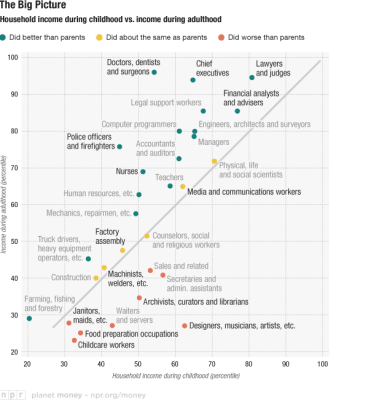
I’ve been sitting on this figure for awhile. Steven Lubar (@lubar) from Brown University lobbed the associated NPR story at me on Twitter in response to one of my posts on museum economics and professional salaries. NPR staff had been debating the question “who had richer parents, doctors or artists?” To settle the dispute, they dug around in the National Longitudinal Surveys from the Bureau of Labor Statistics, which provide data on over >12,000 people for the past few decades.
The data is too interesting NOT to share, but I don’t have any stunning insights about it. I just want to make sure that folks know it exists so I decided to throw the figure out as a Monday Musing. Maybe you will have something to say.
This drop in family income experienced by people who become curators, archivists and librarians didn’t surprise me a bit. I’ve always had the (informal) impression that many of my colleagues made a conscious choice to let themselves slide, economically, compared to their parents (what I’ve dubbed the Museum Sacrifice Measure).
I’m more surprised by the income of the families in which curators originated. The NPR story titles their categories differently in various figures, but if I’m reading them correctly, people who were archivists, curators or librarians, in 2010 came from families that, in 1979, had median family incomes of between $50k and $55k. My (again informal) impression has been that curators by and large came from very prosperous families. This data shows that honor goes to doctors and judges (growing up in families with incomes of $85-$90k) followed by financial analysts and advisors ($80-$90k). Curators (who I assume they lump here with librarians, though as I said the captions are inconsistent) are drawn from the same economic cadre as doctors, dentists and surgeons (as well as nurses, social workers and administrative assistants), right in the middle of the economic pack. Which leads me to engage in a little self-examination, wondering where my assumption (that curators on the whole come from relatively affluent households) comes from.
I wish I wish I wish that the NPR staff had sussed out the connection between parental profession and the field that children chose as they grew up. Anyone interested in poking around in the NLS data to see if we can find that?










This is very interesting, but I think you've misread the graph. The X axis isn't the parents' salaries in thousands, it's percentile. So Curators didn't necessarily grow up in $50-$55k salary homes; they grew up in slightly above middle class level homes (i.e. slightly above the 50th percentile). I think this only changes your interpretation a little bit. Unless $50-$55k is the average income for a generation ago? It's possible, I guess.
Thank you [unknown], for clarifying the axis of the figure. And yes, I think that does not change the overall analysis of the patterns of income and mobility.